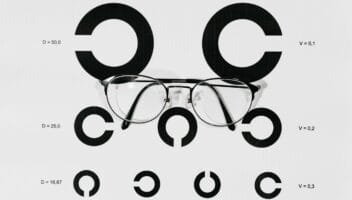Hey there! Let’s chat about something super weird that can happen to your eyes – they are called a visual migraines. Don’t worry, it’s not as scary as it sounds!
Imagine you’re just chilling, maybe scrolling through your phone or watching TV, when suddenly – bam! Your vision goes all funky. It’s like someone turned on a light show in your eyeballs! You might see flashing lights, zigzag lines, or even blurry spots. It’s like looking at a bright light and seeing spots, but it’s way more intense.
Now, you might be thinking, “Oh no, is this a regular migraine?” But hold up! Visual migraines are like the cool cousin of regular migraines. They’re all about the eye tricks and less about the ouch-my-head pain. Some people call them ocular migraines or retinal migraines, too – fancy names for the same wacky eye thing.
In this guide, we’re going to break it all down for you:
– What exactly are these eye-party migraines?
– Why do they happen? (Spoiler: Your brain’s being a bit dramatic)
– How to know if you’re having one (besides the obvious light show)
– What you can do when it happens (hint: it usually involves chilling out)
We’ll keep things super simple and fun, so you don’t need to be a brain scientist to get it. By the end, you’ll be a visual migraine pro, ready to explain it to your confused friends when they ask why you’re staring at a wall like you’ve seen a ghost. Let’s dive in!
Table of Contents
- What Are Visual Migraines?
- Diagnosing Visual Migraines
- Treatment and Management of Visual Migraines
- When to See a Doctor for Your Visual Migraines?
- Living with Visual Migraines
What Are Visual Migraines?

Visual migraines are a type of migraine that mainly affects your vision. Unlike regular migraines that come with severe headaches, visual migraines can happen with or without a headache. When you have a visual migraine, you might see things like flashing lights and zigzag lines or even have temporary blind spots. These episodes usually last from a few minutes to about an hour and then go away on their own.
Visual Migraines Symptoms
When you have a visual migraine, you might experience:
- Flashing Lights: Sudden flashes or bursts of light in your vision.
2. Zigzag Patterns: Shimmering, colorful lines that appear in your vision.
3. Blind Spots: Areas where you temporarily can’t see, usually in the center of your vision.
4. Shimmering or Flickering Lights: Lights that move or flicker, often forming arcs or lines.
5. Tunnel Vision: A feeling that your vision is narrowing, like looking through a tunnel.
6. Complete Vision Loss: Sometimes, you might temporarily lose vision in one eye.
These symptoms can happen alone or with other migraine symptoms like nausea, sensitivity to light and sound, and headaches. However, the visual symptoms are the most noticeable part of visual migraines.
Why Do Visual Migraines Happen?
Visual migraines happen because of changes in blood flow or electrical activity in the brain, especially in the areas that process what you see. These changes are temporary and usually don’t cause lasting damage. But having a visual migraine can be scary if you don’t know what’s happening.
It’s important to know the symptoms so you can understand what’s going on. Visual migraines are usually not harmful, but if you have them often or they are very bad, talk to a doctor to ensure there’s no other cause and find out how to manage them.
Causes of Visual Migraines
The exact cause of visual migraines isn’t fully understood, but several factors might play a role. Let’s break them down:
Genetics
Migraines can run in families. If someone in your family, like a parent or sibling, gets migraines, you might also be more likely to get them. This genetic predisposition means that the genes passed down from your parents can affect whether or not you get migraines.
Blood Flow Changes
Your brain needs a steady flow of blood to work properly. Sometimes, the blood vessels in your brain and eyes can change size. They might get smaller (narrow) or larger (widen). These changes can affect how well blood flows to your brain and eyes, leading to the visual disturbances you see during a migraine.
Nerve Signals
Your brain communicates through electrical signals. During a migraine, these signals can get mixed up. This unusual activity might cause visual symptoms, like flashing lights or zigzag lines.
Triggers
Understanding what triggers your visual migraines can help you manage them better. Keeping a diary of your migraines and noting what you were doing, eating, or feeling before an attack can help you identify and avoid your personal triggers. This way, you can reduce the frequency and severity of your migraines.
Many things can trigger visual migraines. Here are some common ones:
Stress: Feeling stressed or anxious can bring on a migraine. It’s important to find ways to relax and manage stress.
Bright or Flickering Lights: Things like the glare from the sun, bright indoor lights, or flickering screens (like TVs or computer monitors) can trigger a migraine.
Hormonal Changes: Changes in hormone levels, especially in women, can trigger migraines. This often happens during menstruation, pregnancy, or menopause.
Certain Foods and Drinks: Some foods and drinks can trigger migraines. Common culprits include caffeine (found in coffee, tea, and soda), alcohol (like wine and beer), and certain foods like chocolate and aged cheeses.
Lack of Sleep: Not getting enough sleep or having irregular sleep patterns can trigger migraines. Having a regular sleep schedule and getting enough rest each night is important.
Changes in Weather: Weather changes, like a sudden drop in temperature or changes in humidity, can trigger migraines in some people.
Types of Visual Migraines
Visual migraines come in two main types:
Ocular Migraines
Ocular migraines, also called retinal migraines, affect only one eye. You might temporarily lose vision in that eye or see flashing lights or blind spots. This migraine usually lasts less than an hour and then goes away.
To check if it’s an ocular migraine, cover one eye. If the symptoms stop, it’s likely an ocular migraine. If symptoms don’t stop or affect both eyes, see a doctor immediately, as it could be more serious.
Migraine with Aura
Migraine with aura affects both eyes and includes visual symptoms before a migraine headache starts. These can be flashing, blind spots, zigzag patterns, or shimmering lights. Other symptoms might include tingling in your hands or face, difficulty speaking, and hearing things that aren’t there.
The visual symptoms usually start slowly and last up to an hour before going away, often followed by a headache. Sometimes, the headache is mild or does not happen, and it is called a “silent migraine.”
Diagnosing Visual Migraines

Diagnosing visual migraines involves several steps to ensure other health problems do not cause your symptoms. By understanding your symptoms and ruling out other conditions, your doctor can make an accurate diagnosis and help you manage your visual migraines effectively.
Diagnosing visual migraines involves a detailed check-up by a healthcare provider, often a neurologist (a doctor specializing in the brain and nerves) or an ophthalmologist (an eye doctor). Here are the steps they usually take:
Medical History
The doctor will ask you questions about your health and symptoms. They might ask:
- What visual symptoms do you have (flashing lights, zigzag lines, blind spots)?
2. How often do these symptoms happen?
3. How long do the symptoms last?
4. Do you get headaches with your visual symptoms?
5. Is there anything that seems to trigger your symptoms (like stress, certain foods, or lack of sleep)?
6. Does anyone in your family have migraines?
This information helps the doctor understand your condition better.
Eye Examination
The doctor will do a thorough check-up of your eyes. They want to make sure your visual symptoms are not caused by other eye problems, such as:
- Retinal Detachment: This is when the retina (a part of the eye) pulls away from its normal position.
2. Other Eye Diseases: Conditions like glaucoma or macular degeneration can also cause visual changes.
During the eye exam, the doctor might use special tools to look inside your eyes and check your vision.
Neurological Examination
A neurological exam checks how well your brain and nerves are working. The doctor might test:
- Reflexes (how your body responds to stimuli).
2. Coordination (how well you can move and control your muscles).
3. Your balance (how well you can stand and move without falling).
4. Your muscle strength.
5. Sensation (how well you can feel things like touch, pain, and temperature).
These tests help the doctor see if any problems with your brain or nervous system could be causing your symptoms.
Imaging Studies
Sometimes, the doctor might order imaging tests like an MRI or CT scan. These tests take detailed pictures of your brain. They help the doctor check for other possible causes of your symptoms, such as:
- Stroke: A sudden problem with the blood supply to the brain.
2. Brain Tumor: An abnormal growth of cells in the brain.
Imaging studies are not always needed but can be very helpful if your symptoms are unusual or if the doctor wants to rule out other serious conditions.
Treatment and Management of Visual Migraines

While visual migraines can be disruptive and uncomfortable, they are generally not harmful and usually don’t need specific treatment. However, you can manage the condition by making lifestyle changes, taking medications, and trying other therapies to reduce how often and how severe the episodes are.
1. Lifestyle Modifications to Address Visual Migraines
Identifying and Avoiding Triggers: Keep a migraine diary. Write down when you get a visual migraine and what you were doing, eating, or feeling before it happened. This tracking can help you spot and avoid things that trigger your migraines.
Stress Management: Stress is a common trigger for migraines. Techniques like yoga, meditation, and deep breathing exercises can help you manage stress. Even simple activities like walking or spending time with friends can reduce stress.
Healthy Diet: Eating a balanced diet is important. Avoid foods and drinks that trigger migraines, such as caffeine (found in coffee, tea, and soda), alcohol, and processed foods. Try to eat regular meals and avoid skipping them.
Regular Sleep Patterns: Get enough sleep and try to go to bed and wake up at the same time every day. Good sleep helps prevent migraines. Avoid things that disrupt your sleep, like using screens (phones, tablets, TVs) right before bed.
2. Medications
Pain Relievers: Over-the-counter pain medications like ibuprofen or aspirin can help if you get a headache after a visual migraine. Take these as soon as you feel a migraine starting.
Triptans: These are prescription medications that can stop a migraine. They are especially helpful if you have migraines with aura (visual symptoms before the headache). Your doctor can prescribe these if you need them.
Preventive Medications: If you have frequent or severe visual migraines, your doctor might suggest preventive medications. These include beta-blockers, antidepressants, or antiepileptic drugs. You take these regularly to reduce how often you get migraines.
3. Alternative Therapies for Visual Migraines
Acupuncture: Some people find that acupuncture helps reduce the number of migraines they get. This involves tiny needles being inserted into specific points on your body.
Biofeedback: This technique teaches you how to control body functions like heart rate and muscle tension. It can help you manage migraine symptoms.
Herbal Supplements: Supplements like butterbur and feverfew may help reduce migraines. However, their effectiveness and safety can vary. Always talk to your doctor before trying any new supplements.
When to See a Doctor for Your Visual Migraines?
While visual migraines are generally not a cause for concern, you should see a doctor if:
– The visual disturbances come with severe headache, confusion, or difficulty speaking.
– You have a sudden onset of new or unusual symptoms.
– The visual disturbances last for more than an hour.
– There is a big change in the pattern or frequency of your migraines.
Living with Visual Migraines

Living with visual migraines can be challenging. However, you can reduce the frequency and severity of episodes with proper management and lifestyle adjustments.
By making these changes and working with your healthcare provider, you can manage visual migraines and improve your quality of life.
Here are some tips:
Stay Hydrated: Drink plenty of water throughout the day. Dehydration can trigger migraines.
Maintain a Healthy Diet: Eat regular, balanced meals. Avoid known food triggers.
Regular Exercise: Moderate exercise can reduce stress and improve overall health, which can help reduce the frequency of migraines.
Use Protective Eyewear: Wear sunglasses or blue light-blocking glasses to reduce the impact of bright or flickering lights.
Create a Calm Environment: Reduce noise, bright lights, and other sensory stimuli in your environment. This change can help prevent migraine triggers.
Conclusion
Wow! We’ve been on quite a ride learning about visual migraines!
Let’s wrap this up with a fun recap:
Visual migraines are like your brain’s way of putting on a light show just for you. It’s not always fun, but at least now you know what’s happening!
Remember, these eye tricks aren’t usually dangerous. They’re just your brain being a bit of a drama queen. But if they happen a lot or really bug you, don’t be shy – talk to a doctor!
The cool part? You can be the boss of your migraines!
Eat well, sleep enough, and chill out when you can. It’s like giving your brain a big, comfy hug.
So next time your vision goes all funky, don’t panic! Take a deep breath, find a quiet spot, and wait for the show to end. You’ve got this!




